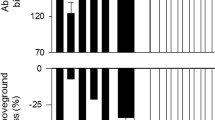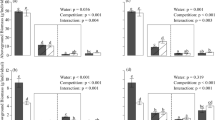Abstract
The ability to competitively suppress native species is key to successful invasion. Since invasions involve an increase in abundance or dominance of a species in its non-native range, competitive effects might be expected to be stronger in the non-native range of an invader; however, there have been few comparisons of the competitive effects of invasive plants on species from invaded ranges versus species from native ranges. We compared the competitive and allelopathic effects of Acroptilon repens on native North American species to effects on related species from the native range of Acroptilon in Uzbekistan. We also compared the competitive interactions among these North American and Eurasian species, in the absence of Acroptilon, examining the hypothesis that particular regional species pools may show differences in competitive ability. The results showed that Acroptilon had stronger competitive effects against native North American species than against species native to Uzbekistan. There was no difference in the competitive effects among Eurasians and North Americans. The effects of leachates collected from Acroptilon roots were weak but more negative on species from North America than on species from Uzbekistan. Our results suggest that inherently stronger competitive and allelopathic effects of Acroptilon on North American plants than on plants from its native range may contribute to its invasive success.



Similar content being viewed by others
References
Abdul-Rahman AA, Habib SA (1989) Allelopathic effect of alfalfa (Medicago sativa) on bladygrass (Imperata cylindrica). J Chem Ecol 15:2289–2300
Alford ÉR, Perry LG, Qin B, Vivanco JM, Paschke MW (2007) A putative allelopathic agent of Russian knapweed occurs in invaded soils. Soil Biol Biochem 39:1812–1815
Alford ÉR, Vivanco JM, Paschke MW (2008) The effects of flavonoid allelochemicals from knapweeds on legume-rhizobia candidates for restoration. Rest Ecol 16:1–9
An M, Pratley JE, Haig T (2001) Phytotoxicity of Vulpia residues: III. Biological activity of identified allelochemicals from Vulpia myuros. J Chem Ecol 27:383–394
Blossey B, Nötzold R (1995) Evolutionary of increased competitive ability in invasive non-indigenous plants: a hypothesis. J Ecol 83:887–889
Booth MS, Caldwell MM, Stark JM (2003) Overlapping resource use in three Great Basin species: implications for community invasibility and vegetation dynamics. J Ecol 91:36–48
Caldwell MM, Eissenstat DM, Richards JH, Allen MF (1985) Competition for phosphorus: differential uptake from dual-isotope-labeled spaces between shrub and grass. Science 229:384–386
Callaway RM, Aschehoug ET (2000) Invasive plants versus their new and old neighbors: a mechanism for exotic invasion. Science 290:521–523
Callaway RM, Maron JL (2006) What have exotic plant invasions taught us over the past 20 years? Trends Ecol Evol 21:369–374
Callaway RM, Ridenour WM (2004) Novel weapons: invasive success and the evolution of increased competitive ability. Front Ecol Environ 2:436–443
Callaway RM, Delucia EH, Moore D, Nowack R, Schlesinger WD (1996) Competition and facilitation: contrasting effects of Artemisia tridentata on Pinus ponderosa versus P. monophylla. Ecology 77:2130–2141
Callaway RM, Ridenour WM, Laboski T, Weir T, Vivanco JM (2005) Natural selection for resistance to the allelopathic effects of invasive plants. J Ecol 93:576–583
Callaway RM, Cipollini D, Barto K, Thelen GC, Hallett SG, Prati D, Stinson K, Klironomos J (2008) Novel weapons: invasive plant suppresses fungal mutualists in America but not in its native Europe. Ecology 89:1043–1055
Cappuccino N, Arnason JT (2006) Novel chemistry of invasive exotic plants. Biol Lett 2:189–193
Chen BM, Peng SL, Ni GY (2009) Effects of the invasive plant Mikania micrantha H.B.K. on soil nitrogen availability through allelopathy in South China. Biol Invasion 11:1291–1299
Choler P, Michalet R, Callaway RM (2001) Facilitation and competition on gradients in alpine plant communities. Ecology 82:3295–3308
D’Antonio CM, Mahall BE (1991) Root profiles and competition between the invasive, exotic perennial, Carpobrotus edulis, and two native shrubs in California coastal shrub. Am J Bot 78:885–894
Daehler CC (2003) Performance comparisons of co-occurring native and alien invasive plants: implications for conservation and restoration. Ann Rev Ecol Syst 34:183–211
Davis MA, Pelsor M (2001) Experimental support for a resource-based mechanistic model of invasibility. Ecol Lett 4:421–428
Fonteyn PJ, Mahall BE (1981) Competition among desert perennials. Nature 275:544–545
Fridley JD (2008) Of Asian forests and European fields: eastern US plant invasions in a global floristic context. PLoS ONE 3(11): e3630. doi:10.1371/journal.pone.0003630
Goldberg DE, Werner PA (1983) Equivalence of competitors in plant communities: a null hypothesis and a field experimental approach. Am J Bot 70:1098–1104
Grant DW, Peters DPC, Beck GK, Fraleigh HD (2003) Influence of an exotic species, Acroptilon repens (L.) DC. on seedling emergence and growth of native grasses. Plant Ecol 166:157–166
Grime JP (1977) Evidence for the existence of three primary strategies in plants and its relevance to ecological and evolutionary theory. Amer Nat 111:1169–1194
Harris GA (1967) Some competitive relationships between Agropyron spicatum and Bromus tectorum. Ecol Monogr 37:89–111
He WM, Feng YL, Ridenour WM, Thelen GC, Pollock JL, Diaconu A, Callaway RM (2009) Novel weapons and invasion: biogeographic differences in the competitive effects of Centaurea maculosa and its root exudate (±)-catechin. Oecologia 159:803–815
Hierro JL, Callaway RM (2003) Allelopathy and exotic plant invasion. Plant Soil 256:29–39
Hierro JL, Maron JL, Callaway RM (2005) A biogeographical approach to plant invasions: the importance of studying exotics in their introduced and native range. J Ecol 93:5–15
Inderjit S, Seastedt TR, Callaway RM, Pollock JL, Kaur J (2008) Allelopathy and plant invasions: traditional, congeneric, and bio-geographical approaches. Biol Invasion 10:875–890
Ismail BS, Chong TV (2002) Effects of aqueous extracts and decomposition of Mikania micrantha debris on selected agronomic crop. Weed Biol Manag 2:31–38
Kardol P, Cornips NJ, Van Kempen MML, Bakx-Schotman JMT, Van Der Putten WH (2007) Microbe-mediated plant-soil feedback causes historical contingency effects in plant community assembly. Ecol Monogr 77:147–162
Kaur H, Kaur R, Kaur S, Baldwin IT, Inderjit (2009) Taking ecological function seriously: soil microbial communities can obviate allelopathic effects of released metabolites. PLoS ONE 4(3):e4700. doi:10.1371/journal.pone.0004700
Keane RM, Crawley MJ (2002) Exotic plant invasions and the enemy release hypothesis. Trends Ecol Evol 17:164–169
Kulmatiski A (2006) Exotic plants establish persistent communities. Plant Ecol 187:261–275
Lesica P, Atthowe HE (2007) Identifying weed-resistant bluebunch wheatgrass for restoration in Western Montana. Ecol Rest 25:191–198
Levine JM, Vilà M, D’Antonio CM, Dukes JS, Grigulis K, Lavorel S (2003) Mechanisms underlying the impacts of exotic plant invasions. Proc R Soc B 270:775–781
Mallik AU, Pellissier F (2000) Effects of Vaccinium myrtillus on spruce regeneration: testing the notion of coevolutionary significance of allelopathy. J Chem Ecol 26:2197–2209
Maron JM, Marler MM (2008) Field-based competitive impacts between invaders and natives at varying resource supply. J Ecol 96:1187–1197
Mealor BA, Hild AL (2006) Potential selection in native grass populations by exotic invasion. Mol Ecol 15:2291–2300
Mealor BA, Hild AL (2007) Post-invasion evolution of native populations: a test of biological resilience. Oikos 116:1493–1500
Meiners SJ (2007) Apparent competition: an impact of exotic shrub invasion on tree regeneration. Biol Invasion 9:849–855
Miller TE, Werner PA (1987) Competitive effects and responses between species in a first-year old-field community. Ecology 68:1201–1210
Morrow LA, Stahlman PW (1984) The history and distribution of downy brome (Bromus tectorum) in North America. Weed Sci 32:2–6
Newingham BA, Callaway RM (2006) Shoot herbivory on the invasive plant, Centaurea maculosa, does not reduce its competitive effects on conspecifics and natives. Oikos 114:397–406
Ni GY, Song LY, Zhang JL, Peng SL (2006) Effects of root extracts of Mikania micrantha H.B.K. on soil microbial community. Allelopathy J 17:247–254
Parker IM, Reichard SH (1998) Critical issues in invasion biology for conservation science. In: Fiedler PL, Kareiva PM (eds) Conservation biology: for the coming decade, 2nd edn. Chapman and Hall, New York, pp 283–305
Prati D, Bossdorf O (2004) Allelopathic inhibition of germination by Alliaria petiolata (Brassicaceae). Am J Bot 91:285–288
Pyšek P, Richardson DM (2006) The biogeography of naturalization in alien plants. J Biogeogr 33:2040–2050
Pyšek P, Richardson DM (2007) Traits associated with invasiveness in alien plants: where do we stand? In: Nentwig W (ed) Ecological studies, Vol. 193, Biological invasions. Springer, Berlin & Heidelberg, pp 97–126
Quintana N, Weir TL, Du J, Broeckling CD, Rieder JP, Stermitz FR, Paschke MW, Vivanco JM (2008) Phytotoxic polyacetylenes from roots of Russian knapweed (Acroptilon repens (L.) DC.). Phytochemistry 69:2572–2578
Rabotnov TA (1982) Importance of the evolutionary approach to the study of allelopathy. Ékologia 3:5–8. [Translated from Russian]
Ridenour WM, Vivanco JM, Feng Y, Horiuchi J, Callaway RM (2008) No evidence for tradeoffs: Centaurea plants from America are better competitors and defenders than plants from the native range. Ecol Monogr 78:369–386
Sax DF, Brown JH (2000) The paradox of invasion. Global Ecol Biogeogr 9:363–371
Siemann E, Rogers WE (2001) Genetic differences in growth of an invasive tree species. Ecol Lett 4:514–518
Stermitz FR, Bais HP, Foderaro TA, Vivanco JM (2003) 7, 8-Benzoflavne: a phytotoxin from root exudates of invasive Russian knapweed. Phytochemistry 64:493–497
Stevens KL (1982) Sesquiterpene lactones from Centaurea repens. Phytochemistry 21:1093–1098
Stevens KL (1986) Allelopathic polyacetylenes from Centaurea repens (Russian knapweed). J Chem Ecol 12:1205–1211
Tharayil N, Bhowmik P, Alpert P, Walker E, Amarasiriwardena D, Xing B (2009) Dual-purpose secondary compounds: phytotoxin of Centaurea diffusa also facilitates nutrient uptake. New Phytol 181:424–434
Thorpe AS, Thelen GC, Diaconu A, Callaway RM (2009) Root exudate is allelopathic in invaded community but not in native community: field evidence for the novel weapons hypothesis. J Ecol 97:641–645
Valtonen A, Jantunen J, Saarinen K (2006) Flora and lepidoptera fauna adversely affected by invasive Lupinus polyphyllus along road verges. Biol Conserv 133:389–396
Vasquez E, Sheley R, Svejcar T (2008) Nitrogen enhances the competitive ability of cheatgrass (Bromus tectorum) relative to native grasses. Invasive Plant Sci Manag 1:287–295
Vilà M, Weiner J (2004) Are invasive plant species better competitors than native plant species? Evidence from pair-wise experiments. Oikos 105:229–238
Vivanco JM, Bais HP, Stermitz FR, Thelen GC, Callaway RM (2004) Biogeographical variation in community response to root allelochemistry: novel weapons and exotic invasion. Ecol Lett 7:285–292
Watson AK (1980) The biology of Canadian weeds. 43. Acroptilon (Centaurea) repens (L.) DC. Can J Plant Sci 60:993–1004
Wolf JJ, Beatty SW, Carey G (2004a) Invasion by sweet clover (Melilotus) in montane grasslands, Rocky Mountain National Park. Ann Ass Am Geogr 93:531–543
Wolf JJ, Beatty SW, Seastedt TR (2004b) Soil characteristics of Rocky Mountain National Park grasslands invaded by Melilotus officinalis and M. alba. J Biogeogr 31:415–424
Zou JW, Rogers WE, Siemann E (2008) Increased competitive ability and herbivory in the invasive plant Sapium sebiferum. Biol Invasion 10:291–302
Acknowledgments
We are grateful to Aloviddin Khamraev for help with the seed collections, and Courtney Hall and David Hooper for help with the experiments. This research was supported by the Scientific Research Fund of Hongda Zhang, Sun Yat-sen University to GYN, the SCOPES program of the Swiss National Science Foundation to US, the National Natural Science Foundation of China to SLP, and SERDP of the Department of Defense’s (DoD), The Andrew W. Mellon Foundation, the Aldo Leopold Wilderness Center, the USDA-IPM and USDA-NRICP, the National Science Foundation, and the USFS to RMC.
Author information
Authors and Affiliations
Corresponding author
Rights and permissions
About this article
Cite this article
Ni, GY., Schaffner, U., Peng, SL. et al. Acroptilon repens, an Asian invader, has stronger competitive effects on species from America than species from its native range. Biol Invasions 12, 3653–3663 (2010). https://doi.org/10.1007/s10530-010-9759-y
Received:
Accepted:
Published:
Issue Date:
DOI: https://doi.org/10.1007/s10530-010-9759-y




